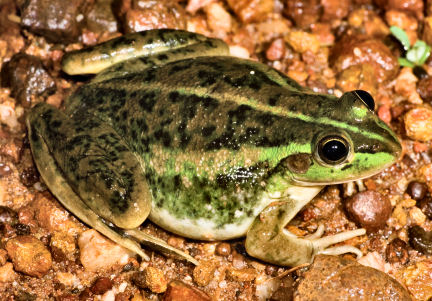A dangerous meal
An Australian snake preys on poisonous frogs by striking them with venom and then waiting for the frog defenses to break down.
Share this:
- Share via email (Opens in new window) Email
- Click to share on Facebook (Opens in new window) Facebook
- Click to share on X (Opens in new window) X
- Click to share on Pinterest (Opens in new window) Pinterest
- Click to share on Reddit (Opens in new window) Reddit
- Share to Google Classroom (Opens in new window) Google Classroom
- Click to print (Opens in new window) Print
It’s impolite to spit out the first bite of your dinner. But to a type of Australian snake, this rude behavior is a matter of life and death.
The snake, called a floodplain death adder, eats two types of frogs that are hard to stomach. The frogs produce chemicals meant to defend them from predators.
 |
|
This Dahl’s frog carries enough poison to kill a snake, but only if the snake eats it immediately.
|
| D. Nelson |
One of these species, the Dahl’s frog, can kill a snake that tries to eat it. The other species, the marbled frog, is less dangerous but still tough to eat. When attacked, it secretes a gluelike substance. Leaves and twigs get caught up in this material, making a big sticky mess that gets in the way of anything trying to munch on it. A marbled frog can even get stuck on the head of an attacking snake.
Both frogs have good defense strategies. But the floodplain death adder knows how to get around each of them.
A team of scientists at the University of Sydney in Australia reports that floodplain death adders quickly strike these frogs, using their fangs to inject venom. But then, instead of gulping down their dinner immediately, the snakes sit back and wait for their prey to become safe to eat.
That’s because both the Dahl’s frog’s protective toxin and the marbled frog’s glue break down over time. After a while, the frog toxin is no longer poisonous, and the glue is no longer sticky.
The two substances break down at different rates, though, and floodplain death adders seem to know the difference, say biologists Ben Phillips and Richard Shine, of the University of Sydney. Their research shows that an adder waits for a different length of time depending on the species of frog it just struck.
In tests, the scientists found that the stickiness of the marbled frog glue decreased by as much as two-thirds after just 10 minutes. And that’s just about how long an adder waits before eating a marbled frog, the researchers report.
On the other hand, the snakes wait for about 40 minutes before eating a Dahl’s frog. That’s enough time for the frog’s toxin to break down into harmless substances, the researchers say.
But even a quick strike gives snakes a taste of the Dahl frog’s toxin. After striking such a frog, a floodplain death adder thrashes around and lies on its back with its mouth open, Shine reports.
“It’s like the snake has just had a mouthful of chili pepper,” he says.
By comparison, when given frogs that have no chemical defenses, floodplain death adders eat their prey immediately after striking. Because these frogs don’t produce any toxins, there’s no reason to wait.
The study shows that snakes may be smarter than many people give them credit for, Shine concludes.
“Snakes, despite the fact that they’ve got this tiny little pea-size brain,” he says “are clearly capable of recognizing what kind of frog they’ve bitten.”







